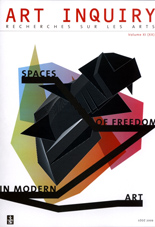Spaces of Freedom: the Role of Geometry in Land Art
Spaces of Freedom: the Role of Geometry in Land Art
Author(s): Paulina SztabińskaSubject(s): Fine Arts / Performing Arts
Published by: Łódzkie Towarzystwo Naukowe
Keywords: geometry; freedom; Land Art
Summary/Abstract: The issue of space played a significant role in 20th century art. The notion evolved from abstract modernist space to real surroundings in which the work, the artist and the recipient all functioned. In this paper, the author addresses the issue of space comprehended in terms of freedom, which was understood very broadly by the representatives of Land Art, i.e. both as artistic freedom and as the liberation of mankind. The Land Artists argued that the works shown in galleries were disconnected from social life, and only functioned as a laboratory of new forms and projects. Therefore, they attempted to invert the relation between the ‘appropriate’ and the ‘inappropriate’ environment for art, looking for sites which were not burdened with cultural meanings, and thus to widen the scope of art’s presence. They were particularly eager to realize their projects in deserts and in remote, isolated, barely accessible spaces. Especially the mountains, prairies and deserts of south-eastern America fascinated them on account of their vast expanses of entirely or almost entirely empty landscape. Such spaces gave them a sense of limitless freedom. At the same time – according to the author – the Land Artists liberated geometric forms from stereotypes and their strong cultural markedness. In their works, geometric forms acquire new, unprecedented meanings, alluding to entropy, decomposition, transience and processuality. These artists demonstrate that the Euclidean shapes do not necessarily convey universal meanings (as was assumed by Malevich and Mondrian, and many artists who followed them) but can be also associated with what is individual and fleeting. Consequently, geometry reveals its descriptive powers; it can be associated with narration (Robert Smithson’s Spiral Jetty), process (the actions of Dennis Oppenheim), the recording of transience and movement (Richard Long), and predominantly the unlimited freedom of space, time, matter and artistic expression.
Journal: Art Inquiry
- Issue Year: 2009
- Issue No: 11
- Page Range: 243-264
- Page Count: 22
- Language: English

